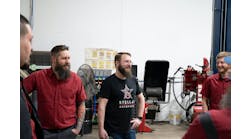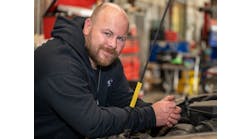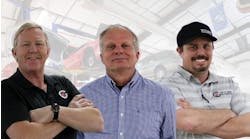Technicians, Jacob Jarrett says, tend to be fickle characters. And, it’s awfully tough to keep a group of them happy.
“I was raised by one, so I kind of have insight into that,” jokes Jarrett, who now works as the service manager at Central Toyota in Jonesboro, Ark.
A few years back, however, the technicians at Central Toyota all came to an agreement: One of the facility’s in-ground lifts was positioned so poorly that it wasn’t being used often, and, it was hurting efficiency all around it. The lift, located near an alignment rack, was positioned awkwardly enough—too close to a shared wall with the facility’s wash bay, Jarrett explains—that it made it tough to get vehicles up on the lift, and even bogged things down with regard to the lift on the opposite side of the shop.
After watching his technicians attempt “12-point turns”—over the course of what felt like 5 minutes—in an effort to access a lift, Jarrett knew the situation needed to be remedied.
“That in-ground lift was kind of in the way, and just wasn’t producing enough hours to be where it was,” Jarrett notes.
Eventually, with frustration mounting around 2011, Central Toyota’s leaders came to the conclusion that they needed to eliminate their lift issue. Because, as Jarrett notes, it’s imperative for a service department to have its workbays laid out in a manner that aids technician efficiency.
“We’ve got to make it where these guys can get what they need, when they need it,” Jarrett
says. “The more time they spend looking for a tool … that’s just lost time for them, and then lost time for the dealer.
“When they’re not turning wrenches, they’re not making us money.”
So, the dealership’s employees—including service managers, advisors, and even
those fickle, often-disagreeable techs—were in agreement: the in-ground lift had to go. They just weren’t sure how to take care of that problem without creating a larger one.
The Problem
Central Toyota, where Jarrett has worked for seven years now, doesn’t have a lot of room to spare in its 11,000-square-foot, 15-lift service area. So, having two lifts bogged down due to a less-than-ideal layout had become irritating by 2011.
“We’re pretty small; the positioning and arrangement of the lifts is a huge deal,” Jarrett notes. “You’re losing a ton of efficiency, because you’re spending five minutes trying to get a vehicle on there without running into anything. … Also, if there was a vehicle longer than a Camry on the lift, you couldn’t hardly maneuver a vehicle onto a very important lift on the opposing side of the shop from” the in-ground lift.
Multiple technicians were groaning. An entire service department staff felt the frustration.
The in-ground lift was in the way, eating up space, and serving as an obstacle to ideal service department efficiency.
“It was either make it a flat bay, essentially, or rearrange the shop,” Jarrett says.
“You know, things look really good on paper when you build these dealerships, but a lot of times architects—the engineers that are designing these buildings—don’t think about how much space it actually takes to get a full-size pickup on a lift. So, it takes employees, seeing how bad it is, to decide to make a change on it.”
The Solution
In 2011, the thorn in Central Toyota’s side was removed. That troublesome in-ground lift was essentially uprooted, and a flat bay was put in its place. Now a sizable steel plate in the ground is all that remains of the old lift.
That bay was then converted into a work area where window tinting was done. And, nowadays, that corner of the service area is often used for jobs like vehicle technology updates, serving as an extra spot to park vehicles for 30 or 40 minutes.
That corner bay is no longer a shop obstacle. It’s now valuable, usable space.
“We were completely not using that bay by the time the lift was removed,” Jarrett notes. “Without the lift there, we were able to repurpose that bay for window tint; looking at it that way, any labor we collect from window tint—around $5,000 per month—is a gain from before the lift removal.”
And, that shop alteration got Central Toyota’s young service manager thinking about other improvements he could make to his facility’s work bays. For example, Jarrett capped an old oil-changing pit with steel caps; his department was left with an express lube lift with a platform at the bottom of it that aids service efficiency.
“We can have a car up to rotate tires, and it basically takes about 12 seconds, as far as lift time,” Jarrett notes. “You can have the rack set and rotate the tires in less than a minute—it’s crazy efficient.”
And, in recent years, Jarrett has taken other steps to increase shop floor efficiency, which already occasionally sees technician efficiency figures of 175 percent. He makes sure his facility’s special service tools cabinet is positioned on the center of his service area, so no technician has to walk long, time-consuming distances to access it. And, he made sure his employees have their own air hose reel attached to the post of their lifts, rather than hanging overhead like at many dealerships—a move that keeps technicians from having to awkwardly stretch a hose across the width of a vehicle.
“We try to work together and find a way of arranging the service area so that we have everything we need,” Jarrett says, and “we’re not overloaded with garbage that we don’t.”
The Results
When Jarrett looks at the corner of his shop floor, where that old, annoying in-ground lift once was, he sees a work area that’s used far more frequently than it was in early 2011. He no longer has to worry about safety concerns with that old in-ground lift, like having a technician accidently back a car into it, popping a tire.
These days, the service manager scarcely hears complaints from technicians, like he did seven years ago. Because the lifelong auto enthusiast—whose department has a 91.5 CSI score, and lifts that typically yield around $90,000 apiece per year in production—learned long ago that it pays to listen to the suggestions of technicians, especially when it comes to laying out a shop floor or work bays.
“There’s a lot of stuff in this business that looks great on paper, that just doesn’t work in the real world, and building design is definitely no different,” Jarrett says. “The engineers and the designers that are making these service facilities, they don’t have to put cars on this rack.
“Trust your technicians. They’re guys that, if it takes him an hour and a half to do a one-hour job—because his setup is not efficient—well, it’s costing him money.
“My advice would be trust your techs; they don’t want to lose time any more than we do.”



